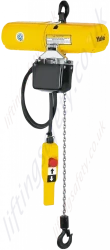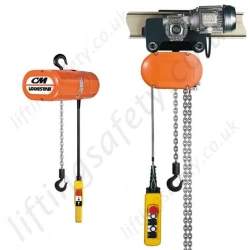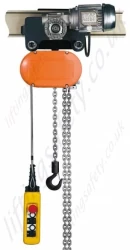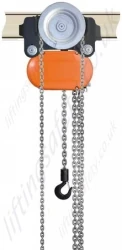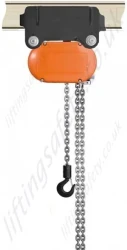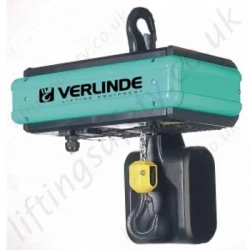110V Electric Hoists
Yale CPS Lightweight Electric Chain Hoist
Yale's light-duty 125kg or 250kg top hook suspension electric hoist in 110v, 230v or 400v.
Model: Yale CPS / LCH1-1003
A small and light weight (only 12kg when 3m HOL) Industrial quality electric chain hoist. Electrical protection to IP54 as standard with low voltage pendant control and overload protection. Smooth operation. Thermally protected hoist duty motor with dual braking system and rugged cast aluminium alloy hoist frame, 5:1 factor of safety yet small, compact design for industrial applications. Hardened forged steel latch-style lower hook rotates 360°.
CM Lodestar Electric Chain Hoist
Heavy-duty 110v, 230v 1ph or 400v 3ph electric hoist built for the hire industry in capacities starting from 250kg up to 3 tonne.
Model: CM Lodestar / ECH1-243
CMLS Single or Three Phase Hoist is a top quality electric chain hoist renowned the world over. The Lodestar is a tough, durable electric chain hoist, designed to keep working in the most arduous conditions. Features include 50% duty rating (30 minutes continuous use per hour). Overload protection and heights of lift up to 60 metres are available.
Capacity available: 250kg, 500kg, 1000kg, 2000kg and 3000kg with hook suspension or with manual trolley or electric power travel trolley.
Verlinde VLA Wind Turbine Electric Chain Hoist
High-speed electric hoists suitable for use with power supply's up to 690v for use on wind turbines. 160kg to 1 tonne.
Model: WTCH-2626
Request QuoteOptions on Wind Turbine Chain Hoist: Safe working load, trolley required, height of lift is 16 to 80 metres.
Wide range of lifting speeds:16 and 4 m/min, 24 & 6 m/min and 32 & 8 m/min, upper and lower electric limit switches
Brake clutch system: DC electromagnetic disk brake made to last as long as the hoist itself.
Hook: Upper hook (detachable) and lower hook complies with DIN standard, Motor: Thermal protection
Yale's light-duty 125kg or 250kg top hook suspension electric hoist in 110v, 230v or 400v.
Heavy-duty 110v, 230v 1ph or 400v 3ph electric hoist built for the hire industry in capacities starting from 250kg up to 3 tonne.
High-speed electric hoists suitable for use with power supply's up to 690v for use on wind turbines. 160kg to 1 tonne.
A Guide to 110V Electric Chain Hoists in the UK
Lifting heavy loads safely and efficiently is a daily requirement across workshops, warehouses, and construction sites. Among the most practical tools for the job is the electric chain hoist, particularly those designed to run on 110V power supplies.
In the UK, 110V chain hoists are widely used on construction and industrial sites where reduced-voltage equipment is required for safety. For workshops and factories with a 230V supply, standard hoists are available, but 110V remains the go-to option for site work.
This article explains how 110V electric chain hoists work, why they are used in the UK, and what to consider before choosing one.
What is a 110V Electric Chain Hoist?
A 110V electric chain hoist is a compact lifting device powered through a 110V transformer, commonly required on UK building sites to comply with Health & Safety Executive (HSE) regulations. Instead of using wire rope, these hoists rely on alloy steel lifting chains to raise and lower loads.
The main components include:
-
Electric motor - drives the lifting mechanism.
-
Load chain - durable alloy steel designed for heavy lifting.
-
Hooks - top and bottom hooks with safety catches for secure lifting.
-
Control pendant or remote - allows safe operation from the ground.
-
Protective housing and gearbox - shield the moving parts and provide torque.
Why Choose a 110V Chain Hoist in the UK?
-
Site Safety Compliance
UK construction sites often mandate 110V tools and equipment to reduce the risk of electric shock. -
Versatility
Chain hoists can be used in confined spaces, attached to a beam clamp or trolley system for easy positioning. -
Durability
Chains withstand twisting, abrasion, and heavy use better than wire ropes, making them ideal for demanding site conditions. -
Impressive Lifting Capacity
Models are available to lift from a few hundred kilograms up to several tonnes. -
Ease of Use
Simple plug-in operation via a transformer makes them convenient and portable across different work areas.
Common Applications
-
Construction sites - hoisting materials, machinery, or tools safely at height.
-
Factories & workshops - lifting components during assembly or maintenance.
-
Warehouses - handling pallets, crates, or equipment.
-
Garage workshops - removing engines or moving heavy parts.
Key Considerations When Buying
-
Safe Working Load (SWL)
Always match the hoist to the heaviest load you expect to lift and leave a safety margin. -
Height of Lift
Standard hoists are supplied with a load chain that provides 3 metres of lift, with considerably longer lift height options available if needed. For example, the CM Lodestar 250kg model can be supplied with a chain collector to suit up to 90 metres of chain and up to 55 metres on the 1000kg (1 tonne) model. -
Duty Rating
If the hoist will be used frequently, choose a model designed for a higher duty cycle to avoid overheating. -
Mounting Options
Decide whether you need a fixed suspension, beam clamp, or a travelling trolley. -
Control Options
Choose between a standard pendant control or a radio remote for greater flexibility and safety.
Maintenance Tips
-
Lubricate the chain regularly to prevent excessive wear.
-
Inspect hooks, latches, and chains before each use.
-
Check cables, controls, and connectors for damage.
-
Store the hoist in a dry, clean environment to avoid corrosion.
-
Never exceed the rated capacity of the hoist.
Conclusion
In the UK, 110V electric hoists are an essential part of safe lifting operations, particularly on construction sites where reduced-voltage equipment is mandatory. Compact, durable, and versatile, they provide a reliable way to move heavy loads with minimal effort.
Whether you're working in a warehouse, workshop, or on-site, choosing the right hoist means considering load capacity, duty cycle, lift height, and safety compliance. With proper care, a quality electric chain hoist will provide years of dependable service.


